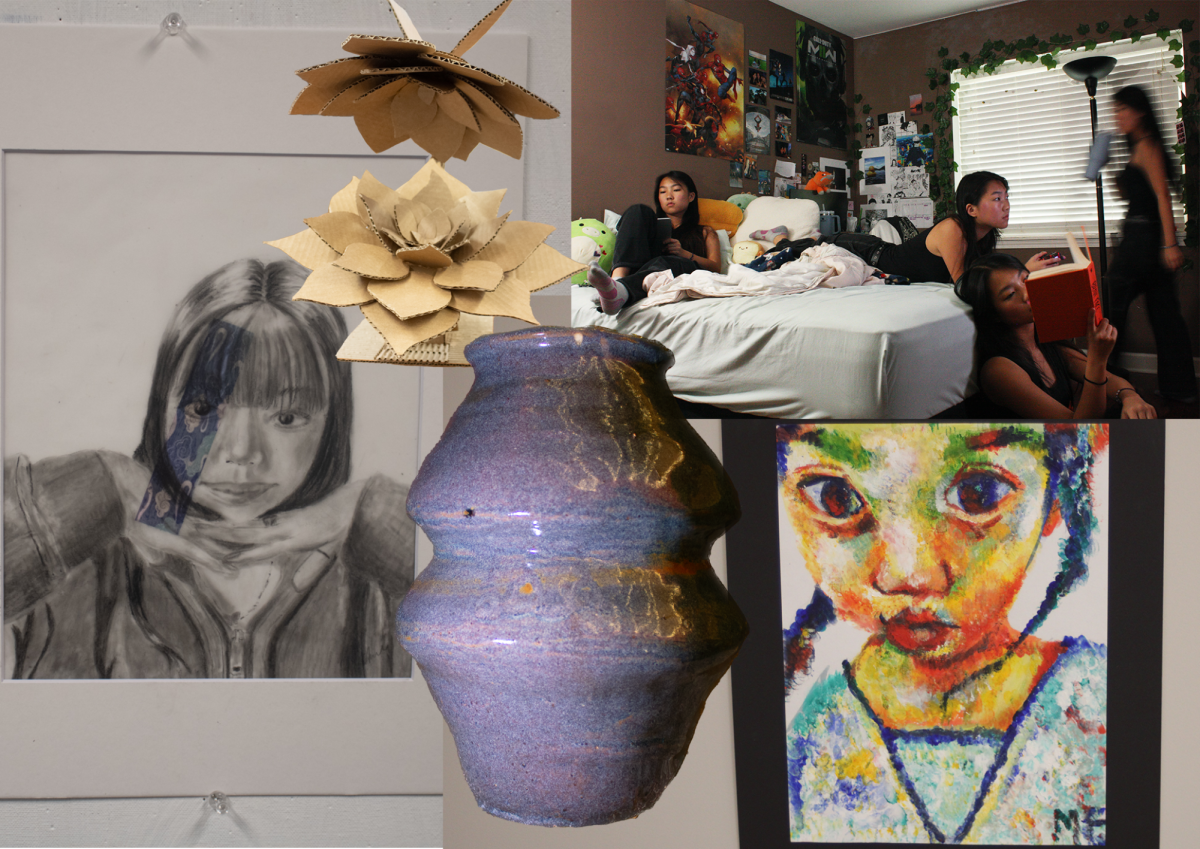Photography
Click. One snap of a camera is all it takes to capture a photo. However, it takes skill to express the desired artistry and emotion within that photo, Art Teacher Amie Elliot said.
Photography is a Visual Art elective offered in four levels to students: Photography 161, Photography 261, Photography 361, and Photography 461, all taught by Elliot. These classes explore both digital and film photography, Elliot added. In Photography 161, students learn shadows, composing, angling, and how to use Photoshop, while in more advanced photography classes, Elliot creates more open-ended assignments and helps students expand on their Photoshop skills. Sophomore Grace Tekip felt drawn to take photography due to its unique creative process compared to other mediums of art.
“[In] drawing and painting, [students] put in a lot to make [their artwork] look good, whereas photography, the creative process is thinking [about] what the picture will [look like] and how [different techniques fit] into the finished product,” Tekip said.
Photography helps teach students to notice the smaller details, not just within photography, but the finer details in the world, Tekip said.
“[After taking photography, I started] noticing the little things that most people would not think twice about,” Tekip said.
Painting
When sophomore Alyssa Carlson chose to take Painting, she felt ashamed of her artwork. Still, after honing her craft and building her confidence, she can accredit her painting class to a newfound sense of certainty in her skills.
Painting is offered in two separate levels as an elective: Beginning Painting 161 and Advanced Painting 261, taught by Art Teacher Stephanie Fuja. Painting class, like Drawing class, focuses on the principles of art that build the base for other art forms, Fuja said. In her Painting classes, Fuja teaches skills like brush strokes and composition and puts emphasis on learning the color wheel, a fundamental of not just painting, but all art that involves color. In her Beginning Painting class, Carlson was taught color theory and how to blend colors
“For Painting, the main [art concept] you learn is how colors work,” Carlson said. “The first project [in Beginning Painting] is working with the color wheel and understanding how they mix.”
Senior Lainy Hill was not a fan of painting, only taking it to prepare for Advanced Placement (AP) Art and Design; however, she quickly saw the usefulness of the art form.
“I hated painting — I wasn’t good at it,” Hill said. “But, I learned to love it. [There] was a learning curve, but I learned so much [from Beginning Painting].”
Sometimes we can be our own biggest critic, but painting taught Carlson to step away from negative perceptions of her art.
“Taking [Painting] helped me develop who I am as an artist,” Carlson said. “It gave me a confidence boost I never had before. Now, instead of hiding away and keeping my [paintings] hidden, I am proud of them and willing to show them off to my family and friends.”
Sculpture
Creativity and perseverance: the traits necessary to succeed in Sculpture.
Sculpture, a three-dimensional Fine Art class, offers both Beginning Sculpture 161 and Advanced Sculpture 262, taught by Art Teacher Alex Remeniuk. The very first project in Beginning Sculpture 161, involves making art with a styrofoam cup, showing the “out of the box” thinking required in sculpture. Sculpture typically works with unconventional materials, like cardboard, plaster, and wire, to create a piece of art very different from what could be made in the other Visual Art classes, Remeniuk said. Taking a sculpture class gave senior Anna Klatt a nuanced perspective on art.
“When you do two-dimensional art, you can not grasp the three-dimensional aspects of the art,” Klatt said. “Building two-dimensional [art pieces] into the three-dimensional form [in Sculpture] can help with the perspective.”
Drawing
Many students have vivid childhood memories of drawing- doodling colorful yet incoherent masterpieces. Beginning Drawing 161 and Advanced Drawing 261 are both electives that allow students to express their inner creativity through drawing while learning the techniques necessary to make it look cohesive, Art Teacher Stephanie Fuja said.
In Drawing class, students explore mediums such as pens, colored pencils, oil pastels, and charcoal, Fuja said. Drawing involves learning about observational drawing, controlling shadows and highlights, positive and negative space, and organic geometrics, and more to improve student’s techniques, Fuja added. They additionally practice performing these skills through portraiture, landscaping, and drawing still lives, Fuja said. The skills learned in Drawing are important as they are the fundamentals of art and many of them apply to other forms of art, Fuja explained. Senior Annie Ostrozhansky finds the relaxing class a breath of fresh air in a rigorous school day.
“[Drawing] is a break from all the academic classes,” Ostrozhansky said. “It’s nice just to relax and do something that I enjoy.”
The class also allows students to build a classroom community accepting of each other’s art, whether they are confident in their piece or not, senior Lainy Hill said.
“You can tell when someone isn’t confident in their piece and it brings people together,” Hill said. “You point out the good things in it and tell them not to worry, there’s always next time.”
Ceramics
In Room 1119, tucked away from the rest of the school in the Visual Arts hallway, sophomore Grace Tekip tunes into the indie-rock song playing in her Beginning Ceramics class as she allows her fingertips to seep into the clay on her potter’s wheel, meticulously folding the clay into place.
Ceramics is an elective offered at South taught by Art Teacher Alex Remeniuk and offered in two levels: Beginning Ceramics 161 and Advanced Ceramics 261. Beginning Ceramics teaches students how to create pinch pots, coil pots, mold clay slabs, glazing, and how to work with the potter’s wheel, Remeniuk explained. In Advanced Ceramics, Remeniuk strives to use the skills taught in Beginning Ceramics to create more complex projects. Tekip struggled to work with the new fundamentals in clay but persisted in the skill she had never tried before.
“[My] progress throughout the semester was cool to see,” Tekip said. “My first project wasn’t smooth and was very wobbly; my last project looked really good.”




![LEFT, RIGHT, CENTER: Members of the Drama Club gather in the drama room to block their scenes for their incoming production as part of the Glenbrook Story Project. [Left to right] sophomore Riley Talbot, senior Lukas House, and senior James Dravenack act out a scene called Dragon House Carnival.](https://theoracle.glenbrook225.org/wp-content/uploads/2025/05/MG_4193-800x1200.jpg)


